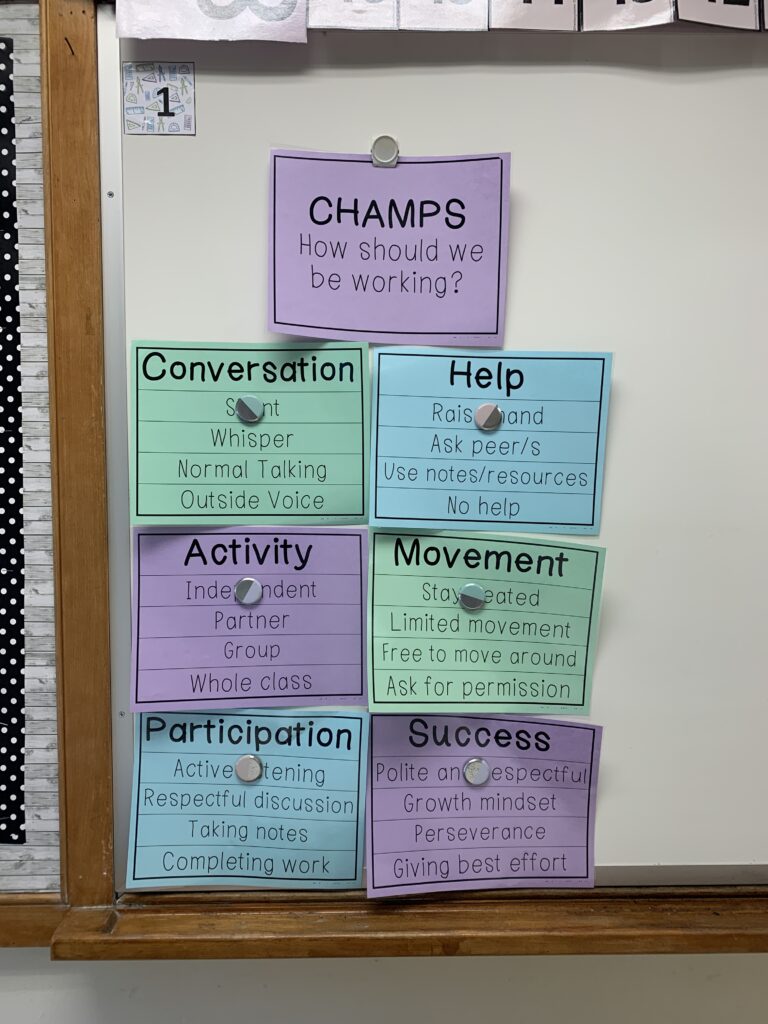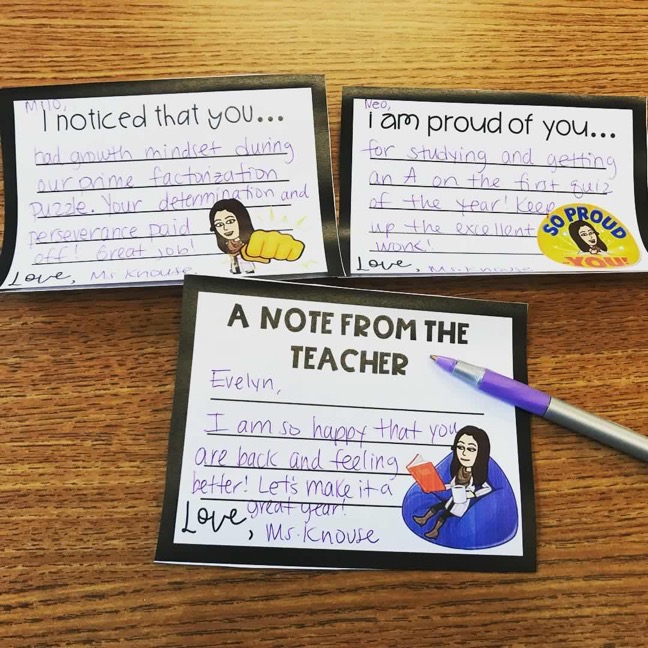
Classroom Management: How to Manage Middle Schoolers
My Experience
I remember setting foot in my very own classroom for the first time. I was so excited to have a classroom to call my own, to teach by myself, to get to know my students and to help them grow as learners, as mathematicians, as writers, and as digital citizens. But, my first year of teaching was rough (I was teaching, coaching water polo, and getting my Master’s degree) and I remember crying a handful of times. I am a perfectionist, OCD, Type A personality and felt like all the other teachers on my team had better classroom management than I did. In reality, I was just being hard on myself (or so I am told) but that’s how I felt at the time.
So, let’s talk about classroom management; the thing that they don’t really teach you how to do in college (at least not when I was in school). Classroom management is something that many teachers struggle with during their first year of teaching and it can make or break your school year. I’m here to tell you that classroom management does get better! Classroom management is something we learn through teaching experience and we, as educators, have to be willing and ready to adapt for each particular class and child on any given day.
Balance
Classroom management is all about balance and it has taken me nine years to perfect it. I have finally found the balance of humor and fun, confidence and established boundaries, and teaching and learning. Below I will share my classroom management tips for managing middle schoolers and having a successful school year.
Note: The tips I am about to share are what works for me. I know teachers with different classroom management strategies and styles that work wonderfully for them. Use what best fits your personality and your teaching style. The tips I am sharing need to be implemented and reinforced every day, starting on the first day (otherwise May/June will be a nightmare for you and no one wants that).
Classroom Management Tips
- Relationships
- Values Rather than Rules
- Routines and Procedures
- Consistency
- Positive Encouragement
- Apologize
- Humor
- Be Yourself
Relationships
“Relationships first, everything else second.” -Kayla (Delzer) Dornfeld @topdogteaching
This statement could not be more true. Once you build relationships, everything else falls into place. In my experience, I typically do not have many behavioral issues in my classroom because I work hard to establish and maintain relationships and connect with every single kid. I get to know my students, their personal lives, hobbies, strengths, weaknesses, etc. I show up to sporting events, choir/band concerts, musicals, and any other event I am invited to attend. I put their names into word problems and plan lessons around activities they enjoy. These small things seem so simple but make a world of difference.
When students feel appreciated, loved, and supported in your classroom, they respect you and are more inclined to meet your expectations. Now, of course, there are some exceptions to this. I have had great relationships with kids who acted out in my classroom from time to time. Talk to them, find out the root of the problem, and work with them to remedy it.
Values Rather than Rules
Ever heard the saying rules are meant to be broken? Well, some of our students perceive rules this way. Instead of having class rules, I like having class values. It puts a more positive spin on rules and blends both rules and values interdependently.
I believe that words are powerful and research shows that kids will become whatever you tell them they are. If I tell students they are helpful, I have found that they will be more helpful. This, in my opinion, is true for any value. By having a value that states, “In this classroom, we will help others”, I’m not telling kids what they can or cannot do in a rule form. I am telling them character traits that represent who they are, who they should strive to be, and what is expected from me. Having class values vs. class rules changed the culture and dynamics of my classroom. Create the values together as a class, display them in your classroom, and reference them daily. Grab my Editable Bitmoji Classroom Values.

Routines and Procedures
In my classroom, there is a routine/procedure for everything and that makes the class run smoothly and efficiently. This allows for fewer opportunities for misbehavior. I only have 44 minutes of instruction time per class period so I am all about maximizing this time. I utilize Google slides to display entering the room procedure. As soon as students walk into my classroom, they know what they can expect to accomplish that day (agenda), what materials they will need for the day, and to begin working on their Bell Ringer. I highly recommend utilizing a Bell Ringer, a warm-up, every day to get students settled, in a routine, and thinking about your subject. Another great option is to have students silent read in place of a Bell Ringer. I am expecting my students to follow the directions on the slide independently. I also set a timer and display it in on my board so all students can monitor their progress over time and it helps hold me accountable if I get distracted or caught up in working with a student.

However, this is not my only procedure. There is a procedure for going to the bathroom, going to the nurse (unless it’s an emergency), transitioning, borrowing a book/ calculator, borrowing other supplies, working in groups, working with partners, etc. I could tell you all of my routines and procedures but you need to develop routines and procedures that make sense to you, your classroom, and your students.
This year I am using the acronym CHAMPS to ensure students know the expectations for working in terms of how to talk, how to get help, the activity, how to move, how to participate, and how to be successful. Simply put a clothespin or magnet on the expectations of CHAMPS. I am also utilizing routine posters for starting and ending classes. Check out the bundle here!

Consistency
Consistency is key. Many students, especially middle schoolers, are creatures of habit. They crave structure and organizational systems that give them a sense of safety and predictability. Middle schoolers are also very intuitive and watch our every move, interaction with students, etc. Be consistent with how you treat students and the plans you put in place for assisting students. If someone gets “special treatment”, students notice. They see this as unfair and some will most likely act out. In middle school, expectations are black and white; middle schoolers do not see any gray area. Being consistent ensures that all students know your expectations and the consequences for not meeting those expectations.
Being consistent can sometimes be tough. I have perceived myself to be consistent but then students may point out an instance where I was not. In my quarterly check-ins with students, I will ask if they feel everyone is being treated equally and fairly in my classroom. Constantly re-evaluating your teaching practice is necessary to guarantee that you are being consistent and fair in the eyes of your students.
Positive Encouragement
Classroom management cannot consist of just discipline and reprimands; there needs to be positive encouragement. I make it a point every day to give out encouraging notes to my students when I catch them being awesome, persevering through a tough problem, sharing an innovative idea, helping a classmate, crushing a test, etc. I use my encouraging notes to build relationships and community in my classroom. I keep a list and give one to every single student. Once I’ve gone through my entire roster, I reset and continue to give these out all year.
Recognizing the good in all students can sometimes be tough in just a 44 minute class period. I start with those kids first; you know the ones I am referring to. I purposely seek to find anything awesome that I can praise them for. Building relationships with these kids first will set the tone for the year. If you can hook them in the beginning, it is usually smooth sailing. Students look forward to my notes and it’s an easy way to recognize the positive things going on in your classroom. Grab the Editable Bitmoji Encouraging Notes for Students.

Apologize
Apologize. This is so important and often overlooked. We all have crappy days where sometimes we take it out on our students without meaning to or really even thinking about it. We all have days where we make mistakes, raise our voices, copy the wrong sheet, spill our coffee on a student’s test, etc. Put your ego aside and apologize to your kids. They will appreciate you and respect you more for being human, for being real, and for owning your mistakes/faults. Plus, this is an important character trait to model, especially at the middle school level.
Humor
Humor is how I survive teaching middle school. Just kidding (coffee too of course). Sometimes, you just have to laugh. I have been told that you can hear my laugh from a different level in the building. Humor is an easy way to capture the attention of your class and generate enthusiasm for a lesson. In my class, I will often tell jokes/puns and when no one in the class laughs, you bet I do. Laughter then becomes contagious. This in itself sparks an interest in the topic and probably convinces my students I am a little crazy (who isn’t, right?). You can’t be afraid to laugh at yourself and embarrass yourself; it’s a requirement for teaching middle school.

I remember one of my first years of teaching, I was in the front of my classroom teaching, slipped on a slick spot on my newly waxed floor, and fell on my butt. My class was mortified, jaws dropped, looking like deer in headlights, not sure how to respond. Almost immediately, I began cracking up. I reassured my students I was fine and encouraged them to laugh with me. I laughed until I cried as I pictured myself falling on my butt; that image was on repeat in my brain.
Note: Be careful using sarcasm in the classroom. Depending on the developmental and emotional level of your students, they might not understand it. It’s also easy to spiral out of control. Sarcasm and humor can go hand-in-hand and trust me, I use both (at times) but not at anyone’s expense except my own.
Be Yourself
Last, but not least, just be yourself! Students can tell when you are not being real and genuine. During my first-ever formal observation (where my math supervisor came to observe me), I turned into a completely different teacher. One of my students approached me after my admin had left and said, “Wow, you were totally different with him in the room.” The reality was, I wasn’t even aware that I acted differently. Then, I thought about it. I am normally super energetic and moving all over the room, constantly laughing and having fun, and I must have toned it down to “business as usual” attitude. That is just not my personality or teaching style. My next observation was equally as uncomfortable as the first but I stayed true to myself and my personality, and let that shine in the observation.
Bring your hobbies, interests, stories, etc. into the classroom. My uncle was a captain of a navy battleship so naturally, during our unit of study with coordinate planes, we played Coordinate Plane Battleship and I showed my students pictures of my uncle and the battleship he commanded. I described his fierce and savage, “do anything to win” type of attitude that helped him have a successful career as he led our country to victory. Students love to hear about our families and our lives outside of school (wait, we have one?). Again, this helps build a repertoire with students and connect with them on a deeper level.
Concluding Thoughts
It’s not easy managing middle schoolers with raging hormones, sassy attitudes, and vulnerable self-esteems but it sure is worth it! The last piece of advice I can offer is to observe other more experienced teachers. Sit in on a class and take notes about how they manage procedures and routines, manage transition times, interact with students, etc. Then, adapt what you loved to fit the unique needs of your students, your classroom, and stay true to yourself. Hopefully, you will find these classroom management tips useful. If you have any other classroom management strategies that work well, comment below!



4 Comments
Ann Adkins
Great read!
sixthgradeteachers
Thank you, Ann! I am glad you enjoyed the post!
Jessica
Great information! I just finished my second year of teaching. I taught 4th the first year, 3rd the second and now I’m teaching 6th this year. I’m so nervous!
sixthgradeteachers
You will love sixth grade! Please let me know if you need anything, Jessica!